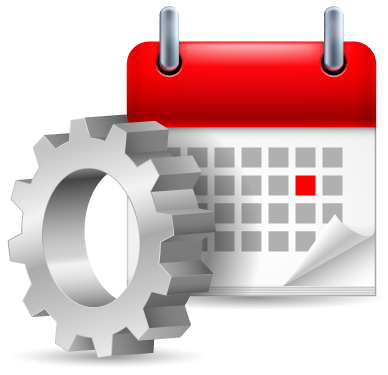Reliability Centered Maintenance (RCM)
Reliability Centered Maintenance (RCM) analysis provides a structured framework for analyzing the functions and potential failures for a physical asset (such as an airplane, a manufacturing production line, etc.) with a focus on preserving system functions, rather than preserving equipment. RCM is used to develop scheduled maintenance plans that will provide an acceptable level of operability, with an acceptable level of risk, in an efficient and cost-effective manner.
 According to the SAE JA1011 standard, which describes the minimum criteria that a process
must comply with to be called "RCM," a Reliability Centered Maintenance Process
answers the following seven questions:
According to the SAE JA1011 standard, which describes the minimum criteria that a process
must comply with to be called "RCM," a Reliability Centered Maintenance Process
answers the following seven questions:
- What are the functions and associated desired standards of performance of the asset in its present operating context (functions)?
- In what ways can it fail to fulfill its functions (functional failures)?
- What causes each functional failure (failure modes)?
- What happens when each failure occurs (failure effects)?
- In what way does each failure matter (failure consequences)?
- What should be done to predict or prevent each failure (proactive tasks and task intervals)?
- What should be done if a suitable proactive task cannot be found (default actions)?
Although there is a great deal of variation in the application of RCM, most procedures include some or all of the following steps.
Prepare for the Analysis
As with almost any project, some preliminary work will be required to prepare for the RCM analysis. Some important up-front activities include assembling an appropriate cross-functional team, making sure that all members of the analysis team understand and accept the ground rules and conditions of the analysis (e.g., scope of the analysis, definition of "failure," etc.), gathering and reviewing relevant documentation, etc.
Select the Equipment to Be Analyzed
Because RCM analysis requires an investment of time and resources, the organization may wish to focus analysis resources on selected pieces of equipment, based on safety, legal, economic and other considerations. Selection Questions and Criticality Factors are two methods of equipment selection that are commonly employed.
- The Selection Questions method consists of a set of Yes/No questions that are designed to identify whether RCM analysis is indicated for a particular piece of equipment. For example, there are four questions in the MSG-3 guideline used to develop initial scheduled maintenance plans for the aircraft industry. If the analyst answers Yes to at least one of the questions, then detailed analysis is indicated for the equipment.
- The Criticality Factors method consists of a set of factors designed to evaluate the criticality of the equipment in terms of safety, maintenance, operations, environmental impact, quality control, etc. Each factor is rated according to a pre-defined scale (e.g., 1 to 5 or 1 to 10) where higher ratings indicate higher criticality. The equipment’s criticality value can then be used as a ranking and/or as a threshold.
Other methods, such as Pareto analysis of equipment based on downtime, unreliability or other relevant metrics, may also be applied. Whichever method (or combination of methods) is selected, the goal is to focus RCM analysis resources on the equipment that will provide the maximum benefit to the organization in terms of safety, legal, operational, economic and related priorities.
Identify Functions and Potential Functional Failures
One of the primary tenets of the Reliability Centered Maintenance approach is that maintenance activities should be focused toward preserving equipment functionality. Therefore, it follows that the first step in analyzing a particular piece of equipment is to identify the function(s) it is intended to perform. Many RCM references recommend including specific performance requirements in function descriptions, which will help to specifically identify functional failures. For example, "To provide hydraulic pressure of 3000 psi +/- 200 psi."
Functional failures describe ways that the equipment may fail to perform its intended functions. This may include failure to perform a function, poor performance of a function, over-performance of a function, performing an unintended function, etc. As mentioned above, the performance limits that have been identified for the function may provide a guide to the functional failure description. For example, "Provides hydraulic pressure of more than 3200 psi," "Provides hydraulic pressure of less than 2800 psi," etc.
Identify and Evaluate (Categorize) the Effects of Failure
Identifying and evaluating the effects of failure will help the team to prioritize and choose the appropriate maintenance strategy to address a potential failure. Many RCM references contain logic diagrams that can be used to evaluate and categorize the effects of failure. These logic structures often differentiate evident vs. hidden effects and whether the issue has safety, environmental, operational and/or economic consequences.
Identify Causes of Failure
The cause of failure (sometimes also called failure mode) represents the specific cause of the functional failure at the actionable level (i.e., the level at which it will be possible to apply a maintenance strategy to address the potential failure). This determination is based on engineering judgment and relies on the team’s experience and skill with the RCM analysis process. The SAE JA1012 guideline presents a useful demonstration of the many levels of detail that can be used to describe failure modes. For example:
- Pump set fails
- Pump fails
- Impeller fails
- Impeller comes
adrift
- Mounting nut undone
- Nut not tightened correctly
- Assembly error
- Nut not tightened correctly
- Mounting nut undone
- Impeller comes
adrift
- Impeller fails
- Pump fails
The recommendation states that "failure modes should be described in enough detail for it to be possible to select an appropriate failure management policy, but not in so much detail that excessive amounts of time are wasted on the analysis process itself."
Select Maintenance Tasks
 Once you have identified the functions that equipment is intended
to perform, the ways that it might fail to perform those intended
functions and evaluated the consequences of these failures, the next
step is to define the appropriate maintenance strategy for the
equipment. The RCM analysis team’s decision of which strategy (or
strategies) to employ for each potential failure may be based on
judgment/experience, a pre-defined logic diagram (connected to the
failure effect categorization), cost comparisons or some
combination of factors.
Once you have identified the functions that equipment is intended
to perform, the ways that it might fail to perform those intended
functions and evaluated the consequences of these failures, the next
step is to define the appropriate maintenance strategy for the
equipment. The RCM analysis team’s decision of which strategy (or
strategies) to employ for each potential failure may be based on
judgment/experience, a pre-defined logic diagram (connected to the
failure effect categorization), cost comparisons or some
combination of factors.
Many RCM guidelines include task selection logic diagrams based on the Failure Effect Categorization. When safety is not an issue, another is to compare normalized cost values for the available maintenance strategies and select the maintenance task that provides the desired level of availability for the minimum cost. For example, if the cost per uptime of performing corrective maintenance only (run to failure) is less than the cost per uptime of performing a scheduled repair/replacement, and the run to failure approach provides an acceptable level of equipment availability (uptime), then the team may recommend no scheduled maintenance tasks for the equipment.
Maintenance Packaging
Once the appropriate schedule maintenance tasks have been identified, the final step is to package them into a workable maintenance plan. This may involve choosing time intervals at which groups of tasks can be carried out most effectively and efficiently.
Published Guidelines and Standards
There are a number of published guidelines and other references to describe the principles and requirements of Reliability Centered Maintenance. Some useful references include:
- Reliability-Centered Maintenance by F. Stanley Nowlan and Howard F. Heap of United Airlines, issued in December 1978.
- ATA MSG-3 "Operator/Manufacturer Scheduled Maintenance Development," updated in March 2003.
- NAVAIR 00-25-403 "Guidelines for the Naval Aviation Reliability-Centered Maintenance Process," issued in February 2001 and updated in July 2005.
- SAE JA1011 "Evaluation Criteria for Reliability-Centered Maintenance (RCM) Processes," issued in August 1999.
- SAE JA1012 "A Guide to the Reliability-Centered Maintenance (RCM) Standard," issued in January 2002.
- Reliability-Centered Maintenance (2nd Edition) by John Moubray, published in 1997.
- Reliability Centered Maintenance: Gateway to World Class Maintenance by Anthony M. Smith, published in 1993.
- "Practical Application of Reliability-Centered Maintenance" by the Reliability Analysis Center, issued in 2003.
- MIL-STD-2173(AS) "Reliability-Centered Maintenance Requirements for Naval Aircraft, Weapons Systems and Support Equipment," issued in January 1986.
- "NASA Reliability Centered Maintenance Guide for Facilities and Collateral Equipment," issued in February 2000.